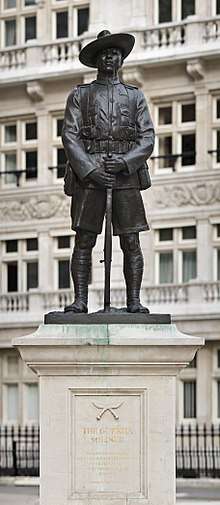Gurkha Contingent
The Gurkha Contingent (GC) is a line department of the Singapore Police Force consisting primarily of Gurkhas from Nepal. Members of the GC are trained to be highly skilled and are selected for their display of strong discipline and dedication in their tasks. The principal role of the contingent is to be a special guard force, and it is currently used as a counter-terrorist force.
| Gurkha Contingent | |||||||
|---|---|---|---|---|---|---|---|
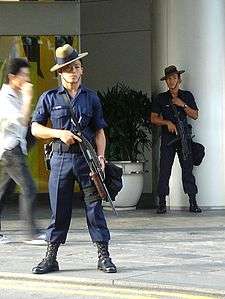 Gurkha Contingent troopers during the 117th IOC Session held there. Dressed in the combat uniform but with elements borrowed from the no.3 dress, the officer in the foreground is armed with a shotgun | |||||||
| Chinese name | |||||||
| Traditional Chinese | 辜加警察團 | ||||||
| Simplified Chinese | 廓尔喀警察团 | ||||||
| |||||||
| Malay name | |||||||
| Malay | Kontingent Ghurka | ||||||
| Nepali name | |||||||
| Nepali | गोर्खाली | ||||||
History
The GC was formed on 9 April 1949 in the wake of Indian independence from the British Empire,with Cpt.Darshan Limbu when Gurkha regiments of the British Indian Army were divided between the Indian Army and the British Army as per the terms of the Britain–India–Nepal Tripartite Agreement.[1] Those transferred to the British Army were posted to other remaining British colonies. In Malaya and Singapore, their presence was required in the Malayan Emergency, and they were to replace the Sikh unit in Singapore which reverted to the Indian Army on Indian independence.
Just a year after their formation, their presence became an asset when racial riots between the Malay and European communities broke out over the disputed custody of Maria Hertogh. The GC troopers were again activated when major rioting erupted all over the country between the ethnic Malays and Chinese on the Prophet Mohammed's birthday from 21 July 1964 till September that same year.
At that time, their presence as a neutral force was important because local police officers were often perceived to be (or were even expected to be) biased towards their own ethnic groups when handling race-related issues, further fueling discontent and violence. Officers who attempt to carry out their duties impartially and in full accordance with the law also faced social backlash from their own ethnic communities, a difficult situation which can even lead to physical harm to individual officers.
In his autobiography, former Singapore Prime Minister Lee Kuan Yew recounted the use of the Gurkha Contingent as an impartial force at the time when Singapore had just gained independence. He wrote:
When I returned to Oxley Road [Lee's residence], Gurkha policemen (recruited by the British from Nepal) were posted as sentries. To have either Chinese policemen shooting Malays or Malay policemen shooting Chinese would have caused widespread repercussions. The Gurkhas, on the other hand, were neutral, besides having a reputation for total discipline and loyalty.
In April 2012, the GC suffered a scandal when nine of its officers were detained for being involved in a fight.[2]
In 2015, two GC officers assigned to protect the Shangri-La hotel opened fire at a suspicious vehicle before it crashed into an anti-vehicle barrier during the Shangri-La Dialogue convention, killing driver Taufik Zahar.[3][4] In 2016, the investigation on the shootings deemed it lawful with deadly force, justified since the GC officers did not have time to determine if the car was carrying weapons or explosives and the driver refused to obey commands to stop.[5]
Manpower and training
Since its formation in 1949 with 142 men, the contingent has grown to over 2,000 in size in 2003.[6] Young men are recruited in Nepal at the British Gurkha camp in Pokhara. About 320 are selected annually in December out of a pool of over 20,000 applications[7] with about 200 eventually joining the GC while the rest will go to the British Army.
Some of the basic physical admission criteria in the recruitment camp include:
- Aged 17+1/2 to 21
- Minimum height of 160 centimetres (5 feet 3 in)
- Minimum weight of 50 kilograms (110 lbs) (7 st 12 lbs)
- Chest circumference of 79 centimetres (31 in) with minimum 5 centimetres (2 in) expansion
- No applicants needing eyesight aids will be accepted.
- Generally good oral hygiene, with up to two fillings, false teeth or a single gap.
Applicants are expected to possess a minimum education level of SLC 3rd Division, equivalent to the GCE Ordinary Level. Upon registration, they have to go through a battery of physical and mental assessments prior to selection, including oral and written tests in the English language, a mathematics test, a board interview and medical examination. The annual selection process, which normally takes 17 days but is spread over four months due to conditions in Nepal, will then assign recruits to either the GC or the British Army.
Upon successful selection, GC trainees are flown to Singapore, and housed at the permanent base of the GC at Mount Vernon Camp where they will receive ten months of training before being deployed for duties. The training phase for GC officers is relatively unknown, although they have been known to use the jungles in Pulau Tekong for training. Arrangements with the Royal Brunei Police Force have allowed Gurkha officers to conduct jungle training in Brunei for several years. Training from external agencies has also been received including from the SAF Medical Training Institute for medical courses.[8]
Organization and rank structure
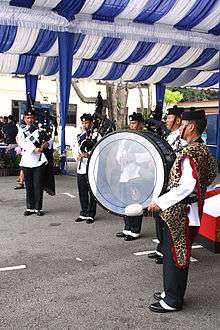
There are a total of nine Gurkha Guard companies commanded by local and British officers. As a British colonial import, the first contingent commander was a British officer, and up to today, it remains the only military or police unit in Singapore to be headed by a British officer seconded from the British Army.
The current commander is Assistant Commissioner Ross Forman.[9] The contingent also has its own Gurkha Band Contingent, the Gurkha Contingent Pipes and Drums Platoon, which is part of the Singapore Police Force Band. The Gurkha Contingent Pipes and drums platoon is commanded by P&D OIC Inspector Prem Kumar Rai.
In addition, the Gurkha Contingent has three tactical forces, in which they are called the Special Action Group, the Special Guard and Counter-Terrorist Unit and the new Special Tactical Unit. The Gurkha Special Action Group was first seen taking part in Exercise Northstar VII as they planned and executed an infiltration of the Marriott Hotel on Orchard Road, subduing two "terrorists" and rescuing the "hostages."
The new Special Tactical Unit took part in Exercise Northstar 10 as they responded to a suicide bombing that "killed" the passengers nearby and the Gurkha, along with some members of the People's Defence Force and airport police officers, disabled the "gunmen" and rescued a "hostage" in Changi Airport Terminal 3.
Ranks
The rank structure of the GC has remained largely unchanged over the years, thus retaining several ranks which have since been abolished in the rest of the police force. It is currently the only unit to retain the rank of Chief Inspector, and to recruit new officers as Constables as opposed to regular officers in the rest of the SPF who start from a minimum rank of Sergeant.
Deployment
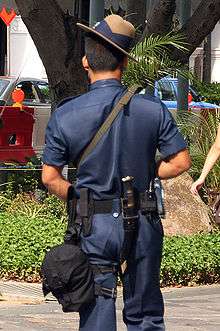
Before the 11 September 2001 attacks, the GC was seldom seen in public besides being stationed at key locations such as the Istana,[10] and the homes of VIPs such as former Prime Minister Lee Kuan Yew and the President of Singapore. Only those who spoke English were assigned to protecting VIP homes. They were also seen stationed at important foreign properties such as the British High Commission and installations which require added security such as the Currency House at Pasir Panjang.
Changing security concerns since 2001 has led to a more active deployment of GC troopers in recent years, and a review of their existing roles. Previously known for standing guard atop lookout towers at Changi Prison where the country's top criminals are housed, this role has since been outsourced to private auxiliary police forces in the mid-2000s with the liberalization of the private armed security industry.
Besides guarding key installations, Gurkha troopers are also increasingly deployed during key national events. They are deployed during the annual National Day Parade, and complemented the police's stringent security measures during the 117th IOC Session held in Singapore in July 2005. In addition, they are also deployed to watch over sealed ballot boxes during the country's general elections. Most recently, the GC was involved in the hunt for escaped detainee Mas Selamat bin Kastari and 2013 Little India riots. GCs are now currently involved with many police and security officers at the MRT station passenger service centers for cash top-up services since 1 September 2017.
On 18 March 2004, three armed fugitives escaped from Johor, Malaysia after committing armed robbery, and fled by a motorized sampan to Pulau Tekong. Over 700 personnel from the police and the SAF were activated, with the first fugitive captured by the Gurkha officers within 34 hours from the commencement of the search operation. The second fugitive was arrested by the Police Coast Guard's Special Task Squadron officers, while the last man was again caught by the GC six hours after the second arrest.[11][12]
Less publicly known is the GC's role in helping to train fellow officers in the police force, as well as other agencies including that of the military. Their fitness, combat and survival skills were imparted through various courses, in return for their help, they have similarly received from other agencies in training GC troopers. Gurkhas occasionally lead police senior officer trainees in runs and other physical training.
The GC has also contributed to Singapore's overseas security and humanitarian missions. For example, GC officers were part of a 40-man Singapore Police Contingent to the United Nations Transitional Administration in East Timor in 2000.[13] They also joined a 30-man team to Iraq to help train about 1,500 local Iraqi trainers and police officers for three months before returning to Singapore on 19 September 2003.[14]
Uniforms
The uniforms of the GC are largely adapted from those of their regular counterparts, adopting the same dark blue outfit but distinguished by their signature headgear, the 'Gurkha hat'. Until recent times, the uniform has remained largely unchanged over the past decades, resulting in increased differences from that of regular police officers. For example, the adoption of embroidered ranks and badges, the abolition of long-sleeved shirts for short-sleeved ones, and the removal of the whistle and chain from the no. 3 dress has not been followed by the Gurkhas. This resistance towards changes to the uniform for the sake of officer comfort and welfare is reflective of the contingent's culture of strict adherence to tradition and the placing of duty above self. From 2006, however, the uniform received radical updates in line with changes to the uniforms of their local counterparts, but the Gurkha hat remains unchanged.
Gurkha hat
The Hat Terai Gurkha is the name of the particular style of slouch hat worn by officers of the Gurkha Contingent in Singapore. A distinctive part of the Gurkha uniform not worn by any other member of the Singapore Police Force, it is named after the Terai region in Nepal, a location linked to the events surrounding the Gurkha War. Worn only during guard duty and on parades, the hat is made of khaki-coloured felt with a dark blue puggaree wound around the hat with six folds. The aluminium silver anodized police force cap badge is affixed on the puggaree to the left. It is always worn with the chin strap and is deliberately tilted far enough to the right that the brim touches the right ear.
The double terai is a version of the terai slouch hat, but with a double thickness crown and brim, designed to give extra sun protection.[15] This hat was almost de rigueur in East and Central Africa from the 1930s to 1950s.[16][17] DARSHAN LIMBU
Traditional Dress No. 3

The Gurkha trooper's no. 3 dress, also called the working dress, is for general duties, including guard duties and on parade. The dark blue outfit, largely adapted from the Singapore Police Force (SPF), included the standard two front breast pockets on the shirt with aluminium-anodized collar badges, buttons and a black plastic name tag atop the right breast pocket. Since removed in the rest of the SPF, but retained by the GC, were the chromed service number pinned above the name tag, and the whistle and chain.
The shirt was long-sleeved and neatly folded up, unlike the short-sleeved versions adopted for the no. 3 dress of the SPF. The sleeves were rolled down when the sun sets, and rolled up again when the sun rises. GC troopers continued to wear aluminium badges of rank, which were worn on the right sleeve, 11.5 centimeters below the right shoulder strap. Constables wore aluminium bars at the outer edges of the shoulder straps. The dark blue trousers were secured by the two-pronged black leather Garrison Belt, and completed by standard-issued black leather boots.
The trooper wears the Hat Terrai Gurkha when on guard duty and while on parade. While on guard duty, he is armed with a pistol and magazine pouch worn on the belt, and with the kukri affixed to the back of his belt. Additional weaponry and equipment may be issued depending on situation needs. When not on duty, the officer dons a blue beret with the metal police cap badge similar to older berets worn by combat officers of the SPF.
Senior Gurkha officers are distinguished by a gold flash on the cap badge. The Duty Unit Sergeant wears an additional red sash with the uniform.
Traditional Dress No. 4
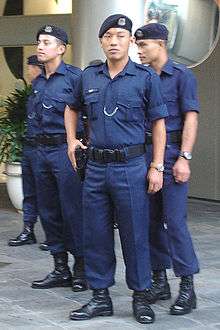
The traditional Gurkha no. 4 dress was adapted from the combat dress of their regular counterparts, and was also known as the night dress, as they were worn during night duty. They were also worn for civil security duty and training, as well as range practices at any time of the day. The long sleeves of the dark blue shirt was similarly rolled up and down depending on duty requirements and time of day, and was devoid of metal accouterments. Junior officers wore their service numbers using white embroidered lettering on a dark blue Velcro backing fixed above their right breast pocket. Ranks were sewn on the right sleeves and made of embroidered, white cloth. The dark blue trousers were tucked into combat boots, and was topped by a dark blue beret.
In the years leading up to major changes to the uniforms in 2006, the GC increasingly adopted the no. 4 dress for active duty in public places, incorporating elements from the no. 3 dress. Officers on duty during the National Day Parade and the 117th IOC Session wore the no. 4 dress but with the Hat Terrai Gurkha. The shirt sleeves were rolled up, and included the metal whistle and chain. In addition, the rank was not sewn to the sleeves, but worn on a dark blue tab affixed to the right breast pocket with the rank in silver embroidered thread similar to that currently used by regular officers.
Less often seen, but formally in frequent use during rioting incidents, is the fire-resistant version of the combat dress, which feature zipper breast pockets and on the trousers. Gurkha officers may also wear the jungle dress, with camouflage-colored uniforms based on the British Army DPM and jockey cap or khaki-colored beret, and complemented by various forms of webbing for paramilitary and military training, duties in rural and forested areas, combat fitness training and when dispatched out of Singapore for overseas exercises.
2006 changes
In 2006, the GC implemented its biggest change to its uniform since the adoption of the present uniform three decades ago, just prior to the commencement of the 61st Annual Meetings of the Boards of Governors of the International Monetary Fund and the World Bank Group as part of Singapore 2006. Khaki-colored berets were worn in place of the dark blue beret. The combat dress (Dress No. 4) was changed to a cotton-polyester material 'BLACK' also known as No 4 Black Dress. The ranks worn on the right breast pocket were maintained in the new uniforms.
Social life and impact

The entire contingent is housed in Mount Vernon Camp, which is their one-stop location for work as well as personal life. While most new recruits come to Singapore alone since they are usually in their late teens or early twenties, they are allowed to bring along their wives and immediate family members to Singapore as they move on into the next phases of their personal lives.
Ultimately, the officers know they are here only on a temporary basis, further enforced by the fact that they are disallowed from integrating too much with local society. Due to their chief purpose as a neutral presence here, they are not allowed to marry Singaporean women, hence the allowance to bring their wives and children from Nepal to the camp. At the end of their contract, they are expected to return to their villages and back to a rural life dependent on agriculture. Only a handful have ever been known to have broken this tradition and chosen to stay in the city-state.
The camp itself is built on a relatively secluded area in Mount Vernon, taking over facilities previously occupied by the reserve units. Comprehensive facilities to create a self-contained township-like complex allows most daily chores and needs to be fulfilled within the camp without too much interaction with the outside world. This also helps to reduce the amount of traffic into and out of the camp for security reasons.
Still, dwellers in the complex are not prohibited from leaving the camp or using services and facilities outside it. Throngs of school-going Nepalese children regularly leave and enter the camp everyday, wearing the uniforms of national schools. The camp's close proximity to Bartley Secondary School has seen a significant number of Nepalese children being enrolled there, although they can also be found in schools much further away as the children become gradually assimilated into Singaporean society and culture. They cannot sink their roots deeply, however, as most of them are in the country on dependent passes, and are compelled to leave Singapore when they turn 21.
Still, most of these young Nepalese are unlikely to follow their fathers' footsteps, and armed with education certificates, are expected to lead quite a different life compared to previous generations should they return to Nepal. The surrounding commercial outlets thrive on business brought about by the Nepalese community based here, and it is a common sight to see officers doing their daily recreational runs around the major roads close to the camp, albeit always in civilian running attire and running alone or in small groups to avoid drawing too much attention to themselves.
The Gurkha community has been known to extend aid to their fellow Nepalese in Singapore, such as during the operation to separate the conjoined twins Ganga and Jamuna at the Singapore General Hospital in November 2001, where they helped to raise funds for the medical procedure and daily expenses, accommodated the family at their Mount Vernon home for a period of time, and assisting in making logistical arrangements for the family's transportation and other needs.[18]
Back in Nepal, the Gurkha Welfare Trust seeks to preserve the legacy and heritage of the Gurkhas with the opening of the Gurkha Memorial Museum on the premises of Hotel Nature Land in Pardi, Pokhara. There, uniforms and badges of the GC are on display together with those from the British Army.[19] Locals and tourists alike have visited the place, a reflection of the high regard local Nepalese hold for their counterparts who have served on these overseas assignments.
Despite their temporary employment basis, it is considered highly honorable to serve as a GC member back in Nepal, and there is always a ready pool of young men eager to join the contingent, with well over 20,000 applications seeking to join the British Army or the GC annually for just 370 places. The good income, their way of life, and affordable education for their children (or future children) are further draws. With the increasing concerns against terrorism and the continued security threat Singapore faces, it is likely the GC will have an increased and sustained role in Singapore's future, despite original intentions of the contingent itself as a temporary security measure during Singapore's turbulent early years.
Immigration status
About 2,000 Gurkha members are employed by the government of Singapore. After three years of service, they are allowed to bring their wives and children to Singapore until the end of their service. However, their children are not allowed to stay after reaching twenty-one years of age. If this rule is not met, they can be arrested by the immigration authorities. The children of Gurkha are only allowed to study in Singapore, and dependents and wives are also not allowed to seek any kind of employment. However, Singapore is currently considering the possibility of granting Singaporean citizenship to Gurkha and their families for services to the homeland.
See also
- Gurkha Reserve Unit – a similar type force in Brunei
- British Indian Army (1858–1947)
- Gorkha regiments (India) - the remaining original parent force
- Royal Gurkha Rifles (British Army)
- Brigade of Gurkhas (British Army)
References
- https://web.archive.org/web/20051102065812/http://www.singapore21.org.sg/art_talent.html
- "9 Gurkha officers arrested for fighting". www.asiaone.com.
- "Shangri-La shooting: Gurkha officers fired five shots at driver who crashed through barriers". The Straits Times. 26 January 2016.
- "Shangri-La shooting: Police identify man shot dead and two arrested". The Straits Times. 1 June 2015.
- "Driver's death in Shangri-La shooting case ruled 'a lawful killing'". The Straits Times. 22 April 2016.
- "2005 Budget Estimates – Ministry of Home Affairs" (PDF). Ministry of Finance. 2005. Archived from the original (PDF) on 16 July 2012. Retrieved 15 October 2005.
- "House of Commons Hansard Written Answers for 5 Jul 2004 (pt 37)". Parliament of the United Kingdom. Archived from the original on 8 February 2006.
- SAF Medical Training Institute – About Us – History 2000. Mindef.gov.sg.
- "Organisational Chart". Singapore Police Force.
- "Gurkha Loyalty Extends to Singapore's Leader". Los Angeles Times. 26 August 2001.
- Archived 1 June 2005 at the Wayback Machine
- "Getforme Singapore THREE FUGITIVES ON PULAU TEKONG CAPTURED FrontPage 21 MARCH 2004". getforme.com.
- "Archived copy". Archived from the original on 20 August 2006. Retrieved 15 October 2005.CS1 maint: archived copy as title (link)
- Archived 17 March 2005 at the Wayback Machine
- Capstick, Peter Hathaway (15 September 1984). Safari: The Last Adventure. ISBN 9781466803985.
- https://books.google.co.uk/books?id=7XQdt37BJ6cC&pg=PA193&lpg=PA193&dq=Double+Terai&source=bl&ots=UTrZ_B1O5W&sig=UijaO0C8NEsX2wXUtpV_uNk-pAI&hl=en&sa=X&ved=0ahUKEwjrtqfumZ7bAhVhDMAKHcBsDx4Q6AEIhwEwCg#v=onepage&q=Double%20Terai&f=false Page 193
- Twigger, Robert (23 May 2013). Red Nile: The Biography of the World's Greatest River. ISBN 9780297866503.
- "Ganga, Jamuna expected to return home in October". The Kathmandu Post. Nepal. 26 August 2001. Archived from the original (reprint) on 8 August 2004.
